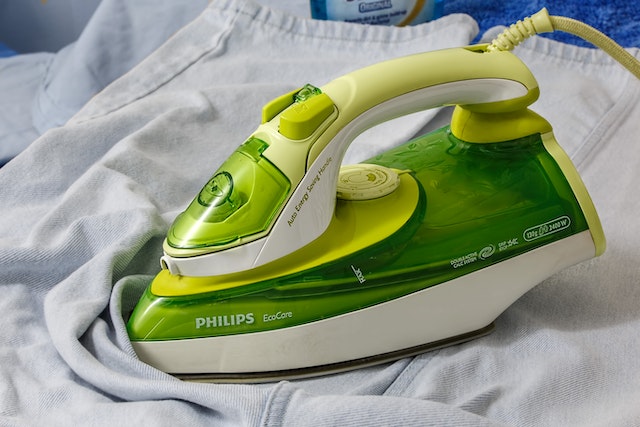
How does an iron remove wrinkles from clothes? The heat forces the cellulose chains to lie straight.
People started wearing clothes about 170,000 years ago. Scientists worked this out by looking at the evolution of lice that live on humans. Lice that live on clothes are different from the lice that live on our bodies and in our hair. It is estimated that we lost our body hair about 1 million years ago, but we lived in the hot climes of Africa, so we didn’t need clothes. The adoption of wearing clothes was one of the factors that allowed us to spread across the globe. People probably washed their clothes, but they didn’t iron them. The first iron was invented in China in about 100 BC. It was a metal pan filled with hot water that allowed people to smooth their clothes. People began to use metal irons, which were made of solid iron and heated in a fire. They are called “irons” because they were originally made of iron. They were heavy because pressure is as important as heat.
So, how does an iron remove wrinkles from clothes? Clothes that are made of plant-based materials, such as cotton, linen, and hemp, contain cellulose. Cellulose is a polymer that is constructed from thousands of glucose molecules joined together in a long chain. Plants use cellulose in their cell walls, and it is what keeps them stiff and strong. It is the fiber in fruit and vegetables that we cannot digest. The cellulose chains are straight, and they are connected to other chains with hydrogen bonds. Cellulose is sticky in this respect because the oxygen molecules on the outside of the glucose are connected by hydrogen to the oxygen on the outside of another glucose molecule. This keeps all of the cellulose fibers together and it gives your clothes their shape.
When you wash your clothes, they absorb water from the washing machine, and this breaks up the hydrogen bonds between the cellulose polymers. Once the hydrogen bonds are broken, the cellulose chains are free to move, and they slide over each other. When you take the clothes out of the washing machine to dry, or when you use a drier, the hydrogen bonds reform in their new position, putting the creases and wrinkles into the clothes.
An iron reverses this process. The steam from the iron loosens up the hydrogen molecules again. The pressure you apply realigns the cellulose chains and the heat evaporates the water, allowing the hydrogen bonds to reform in the correct position. Some materials need a higher heat than others and generally, the higher the heat, the faster the hydrogen bonds can reform. Cotton is very resistant to heat and needs a higher temperature than other materials.
Polyester and nylon clothes wrinkle for a different reason. Natural clothes wrinkle because of water. Polyester and nylon clothes wrinkle because of heat. Both polyester and nylon are synthetic fibers made from petroleum. They are both a type of plastic made from long chains of molecules. They are durable and sometimes cheaper than natural materials, but they are not as good for the environment, and they contribute to plastic waste and microplastics. In fact, it is bad for the environment at pretty much every point in the production process. Polyester and nylon wrinkle in the washing machine because they have a glass transition phase. This is the point where they transition from a stable form to a rubbery and elastic form. For polyester, this temperature is approximately 32 ℃, although it depends on the specific material used. The washing machine usually heats the polyester up beyond this temperature and the polymers become very elastic, moving slightly. As the water in the washing machine cools down, the polyester sets in the new position it is in, becoming wrinkled. When you iron the clothes, the heat makes the polyester elastic again and the pressure straightens the polymers out. If polyester is washed at low temperatures, or dried in a warm tumble drier, it quite often doesn’t need to be ironed.
You can buy non-iron clothes. They are usually made of cotton, but they are treated with a chemical that stops the hydrogen bonds from breaking during the washing cycle. A chemical often used is formaldehyde. The material is treated with formaldehyde and then it is baked in. It stops the clothes wrinkling and it also makes them more stain resistant and prevents mildew. And this is what I learned today.
Photo by Pixabay: https://www.pexels.com/photo/green-white-philips-iron-53422/
Sources
https://www.starletcleaning.co.uk/other/the-history-of-ironing/
https://www.bbc.co.uk/bitesize/topics/znyycdm/articles/z2d2gdm
https://www.americanscientist.org/article/the-chemistry-of-ironing
https://en.wikipedia.org/wiki/Ironing
https://www.education.com/science-fair/article/removing-wrinkles-from-polyester/
https://www.ecuafina.nl/en/blogs/woondekens/how-do-you-remove-wrinkles-from-a-woolen-product/
https://sewport.com/fabrics-directory/polyester-fabric
